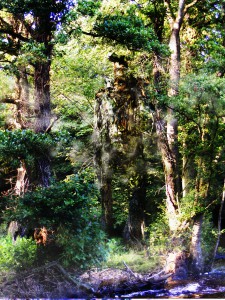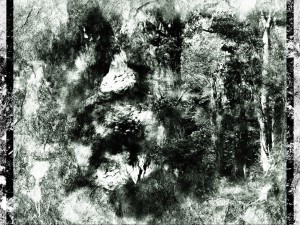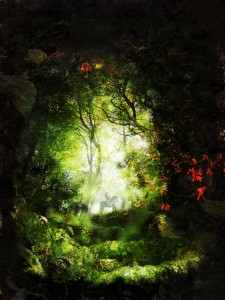The dreams of trees unfold

A song is also the point of one of the most poignant moments of Treebeard’s parsing with the hobbits; the lament of the loss of the entwives is a deeply tragic aspect of their existence. The sorrow of this predicament is evident in the verses of the song in Tolkien’s text and it is also emphasised in the film and Shore’s score as a deep-rooted sadness and searching existential sorrow exemplified by forlorn string writing accompanying sweeping wide shots of the expansive forest.
There is no such expansive treatment in my image The dreams of trees unfold a reference to a line of the verse rather than any assigned musical theme. Depicted is a sense of enclosed woodland space on the edge of a much more expansive scene and Treebeard is almost disguised in the surrounding trees, his focus searches outwards as expanses of time pass in middle-earth and yet the entwives remain lost.
The sorrow of the situation sits in what is also a scene of pleasant fresh-morning daylight and this mirrors the functioning effect of the music, for although this part of Shore’s score is sorrowful it is also one of the more lush and peaceful sections of music in an otherwise weighty and dramatic act for The Two Towers.
“When summer lies upon the world, and in a noon of gold
Beneath the roof of sleeping leaves the dreams of trees unfold;
When woodland halls are green and cool, and wind is in the west,
Come back to me!
Come back to me and say my land is best.”
The Two Towers Chapter IV Treebeard p.467
The Lord of the Rings (J.R.R.Tolkien)

The dreams of trees – portrait and figure (2013) by John Cockshaw.
Encounter in a woodland glade
A meeting of two characters in J.R.R Tolkien’s wider middle-earth writing possesses a tenderly appealing musical aspect and is the focus of the artwork Encounter in a woodland glade.
It can be said that the identity of the meeting couple presented here is not rigidly assigned and many possibilities may be presented, but the scene is ultimately very resonant of the encounter between Beren and Luthien.
Beren, in his far travels, chanced upon the dancing figure of Luthien Tinuviel in the woodland of late evening and was captivated upon this encounter. To express the meeting of this mortal and elf-kind the couple are seen at a distance enveloped in the evening-hued colours of the surrounding woodland, and I’ve deliberately chosen Autumn colours for their rich tones and captivating beauty.
The musical beauty inherent in the natural world is one that I always feel inclined to interpret in Tolkien’s writing and is summarised in this intimate artwork.

Encounter in a woodland glade (2012) by John Cockshaw.
“Tinuviel’s joy was rather in the dance, and no names are set with hers for the beauty and subtlety of her twinkling feet…the ground was moist and a great misty growth of hemlocks rose beneath the trees…there Tinuviel danced until the evening faded late, and there were many white moths abroad…now did he see Tinuviel dancing in the twilight, and Tinuviel was in a silver-pearly dress, and her bare white feet were twinkling among the hemlock-stems”
Chapter 1 The Tale of Tinuviel p.10-11
The Book of Lost Tales Part II J.R.R Tolkien (Unwin Paperbacks)
A very definite biographical slant on the artwork is made in reference to Tolkien’s own life. The village of Roos in Holderness, East Yorkshire is well known to be the location of a similar scene to that of Beren and Luthien where Tolkien’s wife Edith performed a song and dance in a wood full of hemlocks, which made a great impression on Tolkien to the point of it inspiring his written work and extending to the touching story of ‘Beren’ and ‘Luthien’ being engraved on the respective gravestones of John Ronald (J.R.R) and his wide Edith in reference to The Tale of Tinuviel in The Book of Lost Tales Part II by J.R.R Tolkien.
Works cited and sources referenced:
The Music of The Lord of the Rings Films: A Comprehensive Account of Shore’s Scores by Doug Adams. Carpentier / Alfred Music Publishing 2010
The Lord of the Rings by J.R.R Tolkien (Paperback) HarperCollinsPublishers London 2007 (based on the 50th Anniversary Edition published 2004)
The Book of Lost Tales Part II by J.R.R Tolkien George Allen & Unwin (Publishers) (Unwin Paperbacks) London 1986
Yorkshire Tour proves East Yorkshire can be Hobbit forming http://m.yorkshirepost.co.uk/news/ 30 April 2012. Johnson Publishing Ltd
John Cockshaw is a British-based artist who combines landscape, miniature-scale and composite photography to depict locations, dramatic scenes and characters from the enduringly popular stories of J.R.R. Tolkien. His first book, WRATH, RUIN AND A RED NIGHTFALL: The Art of John Cockshaw will be published later this year by Oloris Publishing. This piece, which can also be found on John’s site From Mordor to the Misty Mountains is republished in full here with his permission.


